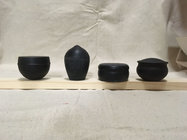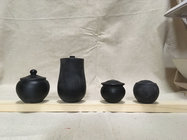There have been a couple of discussions recently about curves and shapes and they made me think my latest project might be worth sharing. Many years ago, while reading a Richard Raffan book, his comment that he took shapes he liked, painted them black, and kept them as models really struck me at the time and I always told myself I would do this one day. A couple months ago, with no project deadline looming, I decided I should finally do it. Also, as someone who totally lacks any artistic sensibility, I have found I need to see and maybe handle something before I can judge whether I like it or not.
This is a very long way of saying that I took some poplar spindle blanks and turned, without hollowing, what might be a box. Then I painted them black. Here they are, in profile.
Some shapes which I've admired (and photographed) in other people's work, I have not been able to visualize in my mind to turn myself, but I kept after these until I had a satisfactory result. One of them took 4 blanks to finally get right. None are exactly 'life-size', as it's all about the shape. Also, I didn't worry about exactly turning the details. I started by planning the dimensions and proportions, but adapted as I went along to get a good shape. Then I wrote down, including on the bottom of each, what those proportions and relative dimensions should be.


This is a very long way of saying that I took some poplar spindle blanks and turned, without hollowing, what might be a box. Then I painted them black. Here they are, in profile.
Some shapes which I've admired (and photographed) in other people's work, I have not been able to visualize in my mind to turn myself, but I kept after these until I had a satisfactory result. One of them took 4 blanks to finally get right. None are exactly 'life-size', as it's all about the shape. Also, I didn't worry about exactly turning the details. I started by planning the dimensions and proportions, but adapted as I went along to get a good shape. Then I wrote down, including on the bottom of each, what those proportions and relative dimensions should be.


